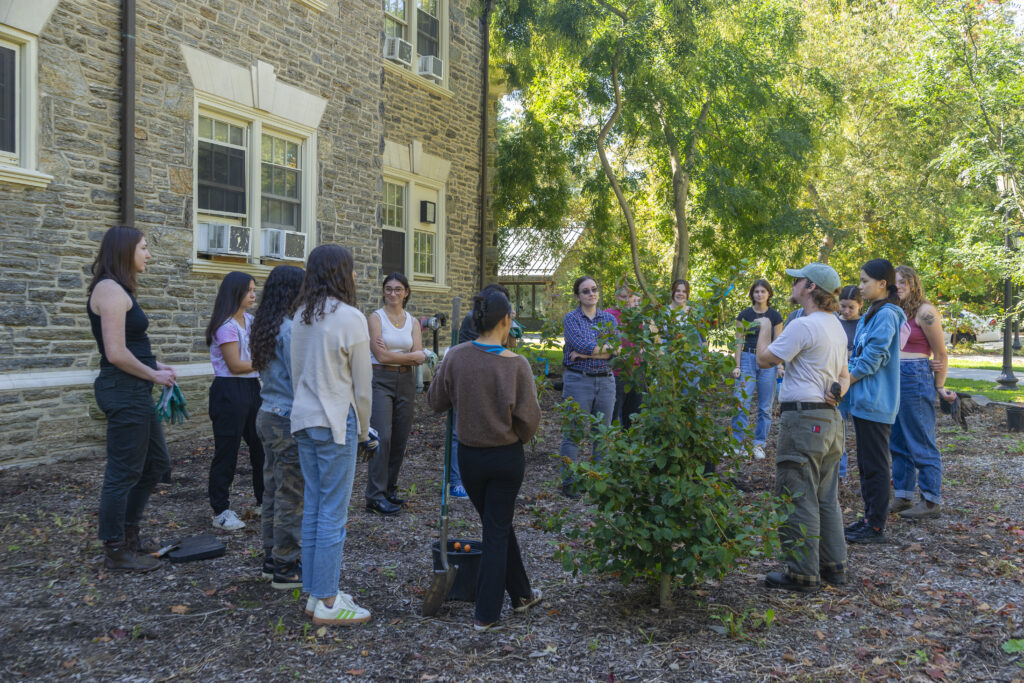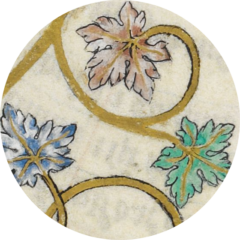Teaching

The Premodern Life of Trees: Interdisciplinarity and Literary Study of the Past
This course seeks to examine premodern literary representations of the natural world alongside historical, scientific, and experiential ways of understanding the environment. Our case study will be the figure of the tree. In collaboration with the Haverford College Arboretum, we will study literature from the premodern world that depicts trees, forests, and gardens while cultivating botanical, artistic, and historical knowledge about the trees of Haverford. We will read classical, medieval, and early modern texts including Virgil’s Georgics, Ovid’s Metamorphoses, Bonaventure’s Tree of Life, Mandeville’s Travels, and Shakespeare’s As You Like It. We will explore theoretical models for thinking about the materiality of the past, including examples from history of science, cultural studies, Indigenous studies, and queer theory. Finally, with the assistance of the Arboretum, we will investigate botanical, archival, artistic, and experiential kinds of knowledge about trees in the present and determine how this expertise can be productively combined with the study of the past. This is a literary studies course with a significant interdisciplinary component that will be useful for students interested in combining textual and material studies, as well as those interested in the history of our relationship with trees and forests.
This class was featured on Haverblog’s COOL CLASSES series!
Dreaming the Medieval Landscape
This course enters the imagined landscapes of the medieval period through one of its most popular genres: the dream vision. We will explore visions of strange forests, mystical gardens, glass temples, and jeweled cities; visions that offer the potential for divine insight into the natural order of the universe but also possess surprising specificity in their plant, animal, and inanimate inhabitants. Our focus will be on literary texts, but our syllabus will also include excerpts from scientific, philosophical, and religious writings of the medieval period. Alongside medieval texts from western Europe and beyond, we will investigate how the contemporary field of environmental humanities has developed over the past fifty years. This interdisciplinary body of critical theory examines the interconnections between human culture and the physical world in the context of anthropogenic climate change. For our purposes, we will trace how the Middle Ages has been characterized as an unenlightened foil to the environmental consciousness of the present—or even as the source of the ideologies that undergird climate change and environmental devastation. We will complicate this narrative of progress by examining how medieval theories of “nature” compare with modern theorizations of the environment, and asking what the fictional landscapes of dream visions meant to medieval writers and readers—and how these texts cause us to reflect on our own environmental values.
Literature and Disability
How are bodies and minds depicted as “normal” or “abnormal,” and how have these categories changed over time and place? This course examines representations of disability in literature from Biblical scripture to modern critical memoir, including disabled saints and saints providing miraculous cures; a fifteenth-century poet’s account of his own madness; William Shakespeare’s depiction of “deformed” king Richard III as choosing to “prove a villain”; and a novel featuring a protagonist disabled by the 1984 Bhopal chemical spill, the world’s worst industrial disaster. We will address how bodily differences and impairments are given social meaning as disability, and how these disabilities are portrayed in literary genres including scripture, hagiography, poetry, drama, novels, short stories, and memoir. We study these depictions from the perspective of disability studies, a discipline that seeks to understand the cultural meanings and material realities of disability with respect to systems of oppression. We will interrogate the definition of the “normal” human body and mind and how this category has been formed, both historically and in the present.
A Queer and Trans Middle Ages
What stories about queer and trans people circulated in the medieval period, and what does this body of literature tell us about the social construction of sexuality and gender? In this course, we will read medieval literature featuring lesbian, gay, transgender, and asexual characters alongside documents of historical queer and trans people and contemporary queer theory and trans studies scholarship. We will examine how medieval literary texts represent gender and sexuality alongside other categories of embodiment, including race, disability, and definitions of the human, and in the context of medical, scientific, and religious discourses. We will address debates about presentism—using the vocabulary and concepts of the present to discuss the past—and the possibilities of using modern identity formations to uncover continuities and discontinuities with the people and literature of the Middle Ages. Texts will include Silence, Yde et Olive, Parliament of Fowls, Sir Gawain and the Green Knight, and The Book of Margery Kempe. We will conclude with trans poet Jos Charles’s 2018 collection feeld, which uses Middle English-inspired language to interrogate the boundaries of gender and signification. All medieval texts will be in modern English translation.
Chaucer: The Canterbury Tales
Geoffrey Chaucer’s fourteenth-century poem The Canterbury Tales showcases a self-effacing narrator, characters drawn from all levels of a burgeoning medieval middle class, and a series of tales strung together by a fragmented frame narrative. This text offers not only the opportunity for an encounter with medieval literature and culture, but also the tools to understand storytelling, representation, and power. We will read The Canterbury Tales guided by a question that the character the Wife of Bath asks in her Prologue. Ranting against the antifeminist writings of clerics, the Wife of Bath describes a painting in which a man is killing a lion. She then asks a question central to the cultural power of representation: “Who painted the lion, tell me, who?” Her implication—that the man’s painting of a lion may not faithfully represent reality because he may have agendas that influence, consciously or not, his depictions—calls into question not only antifeminist clerical writings, but also the entire apparatus of representation. We will investigate and critically interrogate the legacy of the so-called “Father of English Poetry” while examining the enduring power of cultural artifacts such as The Canterbury Tales to be reclaimed and rewritten. We will explore a modern adaptation of Chaucer’s tale collection, such as Patience Agbabi’s Refugee Tales project, ongoing since 2016, a collection of tales in which poets and writers from around the UK interview migrants and refugees and then tell their stories.
The Planetary Premodern
The “Blue Marble,” the first full photograph of the planet Earth from space, was taken by Apollo 17 astronauts on December 7, 1972. Yet, beginning in the writings of the ancient Greeks, humans have depicted Earth as a spherical planet for millennia. This course will explore how poets, philosophers, and early scientists imagined the planet from antiquity to the early modern period. We will question how people understood and represented the planetary environments where they lived, worked, and wrote, before the modern genre of nature writing or political movements like environmentalism. We will investigate medieval and early modern representations of the planet Earth, from descriptions of the natural world to representations of the planet in space. We will examine these works from the perspectives of the fields of literary studies, environmental humanities, animal and plant studies, and history of science. Finally, this course will invite us to discover what possibilities these premodern imaginations of the Earth offer for reconceptualizing environmental, planetary thinking in the 21st century.
Approaches to Literary Analysis: Writing the Weather, Reading the Climate
How does literature help us understand the relationship between humans and our changing ecosystems? This course will explore literary depictions of how people understand their environments through representations of the weather and the climate in several periods and genres of literature. How do writers depict the weather—as an act of a higher power, as the result of more-or-less predictable meteorological processes, as influenced by humans through anthropogenic climate change, or not as “real” weather at all but as a literary trope that echoes the feelings and moods of the characters? Is the weather something that can be predicted, controlled, and managed, or something frightening, dangerous, and wild? How do representations of the weather communicate larger concerns about human agency, the human relationship with nature, the stress and uncertainty of living in unpredictable environments, and the responsibilities of living in the Anthropocene? We will approach these questions through texts including Homer’s Odyssey, William Shakespeare’s King Lear, Emily Brontë’s Wuthering Heights, and Octavia Butler’s The Parable of the Sower, among others. This course will involve reading carefully, thinking critically, and writing and revising short analytic essays. In addition to reading about the effects of the weather on humans, we will also pay attention to our own embodied writing practices and how they are inflected by the environments where we write.
